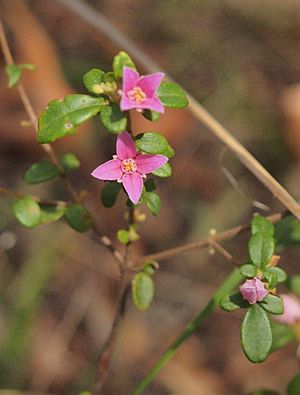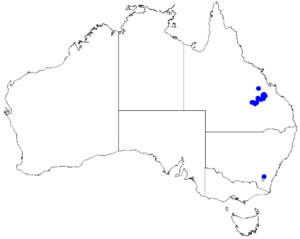Boronia obovata facts for kids
Quick facts for kids Boronia obovata |
|
|---|---|
 |
|
| Scientific classification | |
| Genus: |
Boronia
|
| Species: |
obovata
|
 |
|
| Occurrence data from Australasian Virtual Herbarium | |
Boronia obovata is a type of plant that belongs to the citrus family, called Rutaceae. You can only find it in one special place: the Blackdown Tableland National Park in Queensland, Australia. This means it is endemic to that area. It's a shrub that stands tall with many branches. Its leaves usually have three small parts, and its flowers are pink with four petals.
Contents
What Does Boronia obovata Look Like?
Boronia obovata is a shrub that grows upright and has many branches. It can reach a height of about 2 meters (6.6 feet). Its branches are often covered with white or yellow hairs.
The leaves usually have three small parts, called leaflets. However, very young plants or short branches might have simple leaves with just one part. Each leaf has a small stalk, called a petiole, which is about 1 to 5 millimeters (0.04 to 0.2 inches) long.
The middle leaflet is usually the biggest, measuring 6 to 42 millimeters (0.2 to 1.7 inches) long and 1.5 to 11 millimeters (0.06 to 0.4 inches) wide. The leaflets on the sides are smaller. They are shaped like an oval or a spear, with the narrower end at the base. They also have tiny star-shaped hairs. The edges of the leaflets are often curled downwards.
The flowers are pink and grow in groups of up to three. They appear where the leaves meet the stem, on a hairy stalk about 0.5 to 4 millimeters (0.02 to 0.16 inches) long. Each flower has four sepals, which are like small leaves protecting the bud. These sepals are about 3 to 5.5 millimeters (0.12 to 0.22 inches) long and hairy on their underside.
The four petals of the flower are 4.5 to 8 millimeters (0.18 to 0.31 inches) long and 2.5 to 4 millimeters (0.1 to 0.16 inches) wide. Boronia obovata flowers mostly from January to September. Its fruits ripen a few months later. These fruits are about 4.5 to 6 millimeters (0.18 to 0.24 inches) long and 2 to 3 millimeters (0.08 to 0.12 inches) wide.
How Was Boronia obovata Named?
The plant Boronia obovata was officially described for the first time in 1942. This was done by a scientist named Cyril Tenison White. His description was published in a scientific paper called Proceedings of the Royal Society of Queensland. He studied a plant sample collected by Henry George Simmons.
The second part of its scientific name, obovata, comes from Latin words. Ovatus means "egg-shaped," and the prefix ob- means "reverse." This name likely refers to the shape of some part of the plant.
Where Does Boronia obovata Live?
This type of boronia plant grows in a specific kind of environment. It can be found in eucalypt woodlands and forests. These areas are usually on sandstone rock formations. All of these places are located on the Blackdown Tableland in central Queensland, Australia.
Is Boronia obovata Protected?
The Queensland Government has a law called the Nature Conservation Act 1992. Under this law, Boronia obovata is currently listed as "least concern." This means that, for now, there are enough of these plants, and they are not considered to be at high risk of disappearing.

